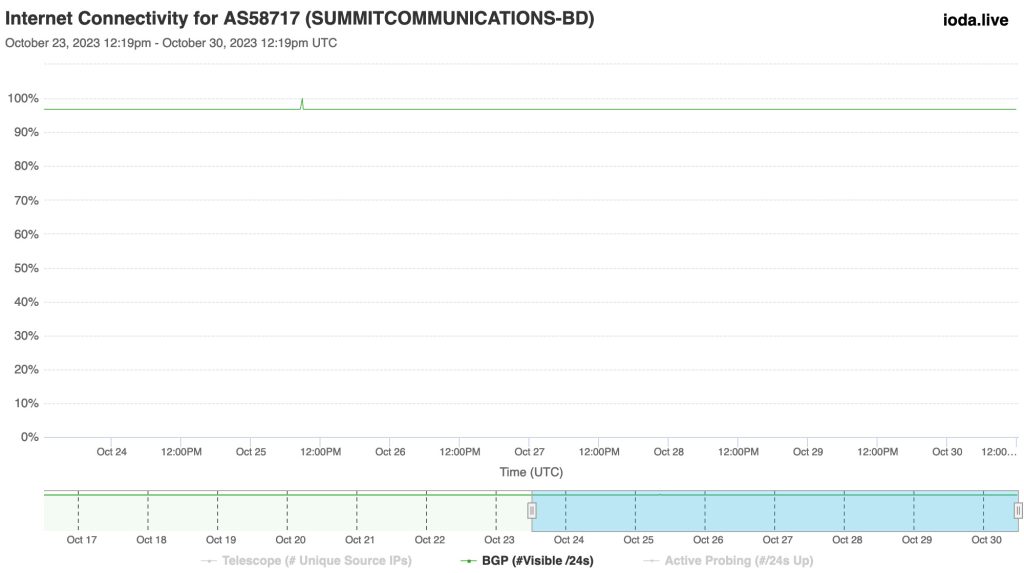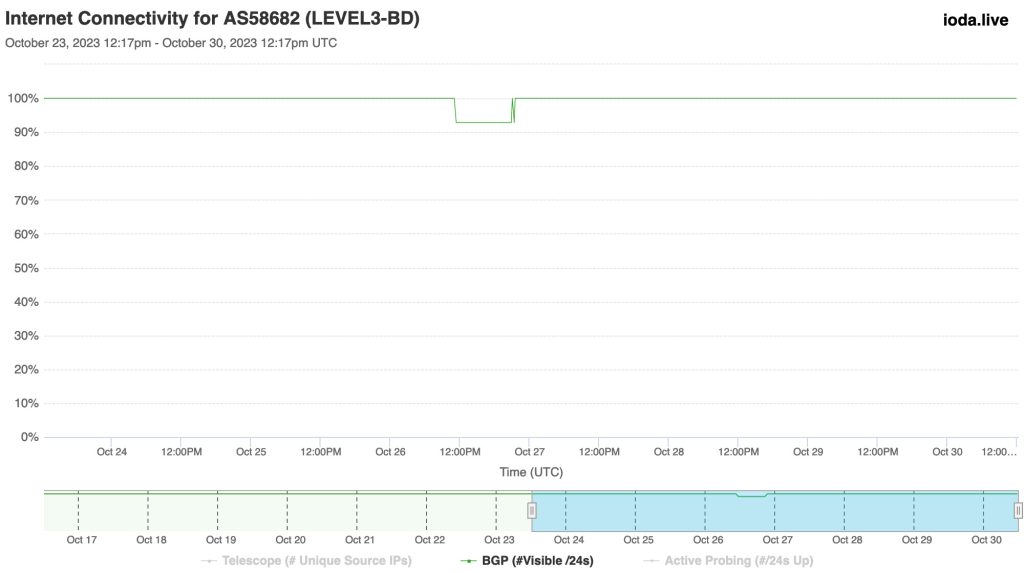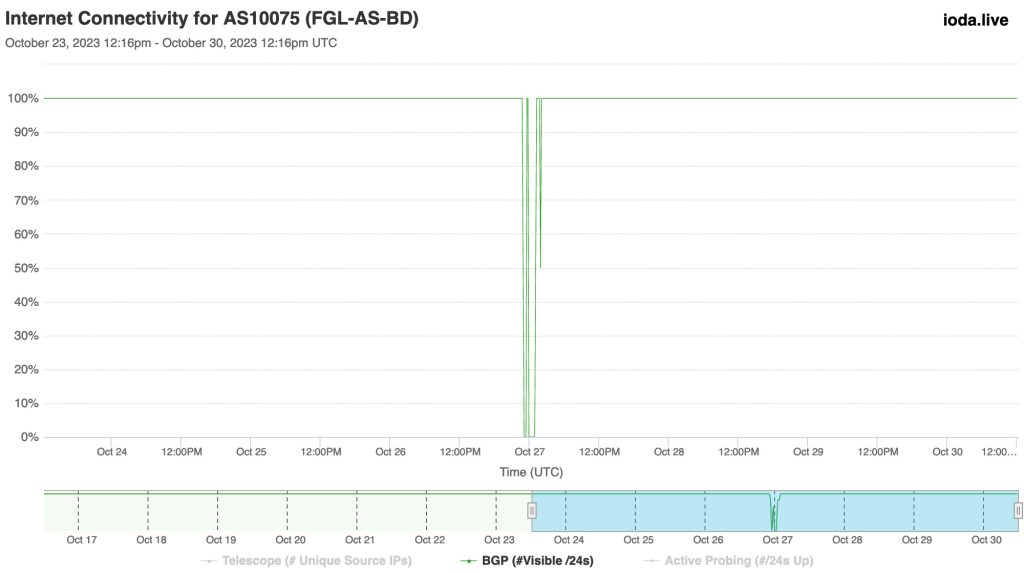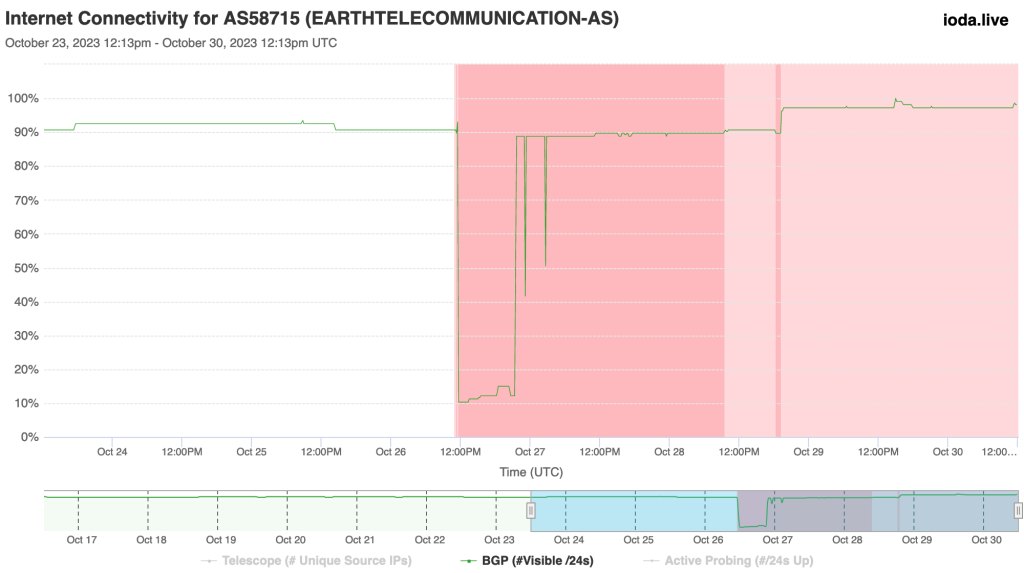
Recently, a fire broke out at the Khawaja Tower in Dhaka, Bangladesh, claiming at least three lives and significantly disrupting the Internet and telecommunication services of the economy.
The tower hosts the operation centres of several International Internet Gateway (IIG) service providers and interconnection exchanges, as well as two data centres. Reports suggest that approximately 30 to 40% of Internet connections were hampered due to the fire, as were mobile Internet and voice telecommunications.
IIGs manage data flow coming and going from an economy, enabling Internet Service Providers (ISPs) and telecom operators to access the global Internet. As of June 2023, Bangladesh has 34 registered IIGs, 124 national ISPs, 479 divisional ISPs, and 2,206 hyper-local ISPs. The latter figures highlight Bangladesh’s excellent retail ISP diversity (Figure 1).
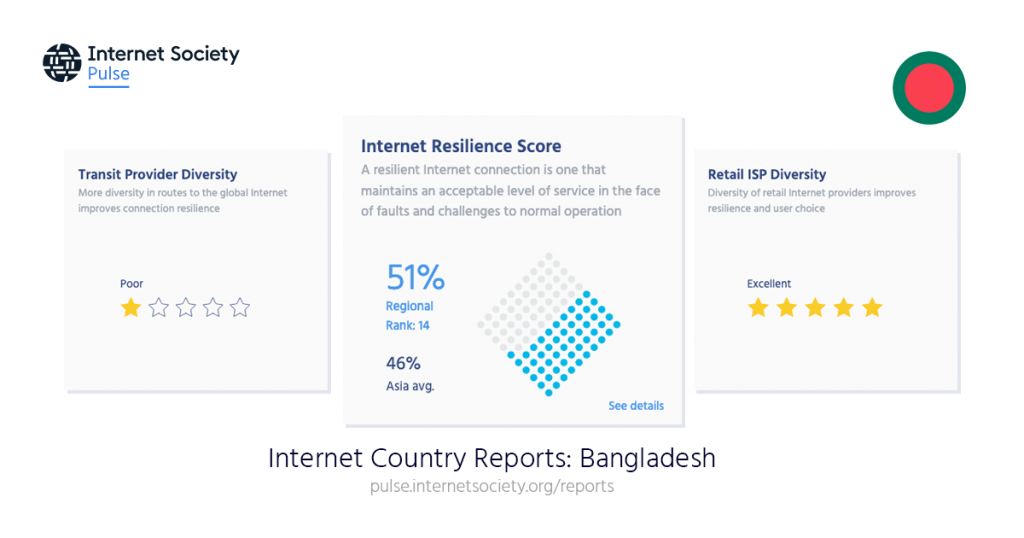
While 34 IIGs might seem like a high number, the reachability of international Internet transit providers in Bangladesh is not distributed equally. As per IIJ’s Internet Health Report (Figure 2), more than half of Bangladesh’s Internet networks are connected through Hurricane Electric’s network (AS6939), while 22% obtain transit via Summit Communications (AS58717), Bangladesh’s largest domestic ISP. These high percentages are behind Bangladesh’s relatively poor Transit Provider Diversity (Figure 1).
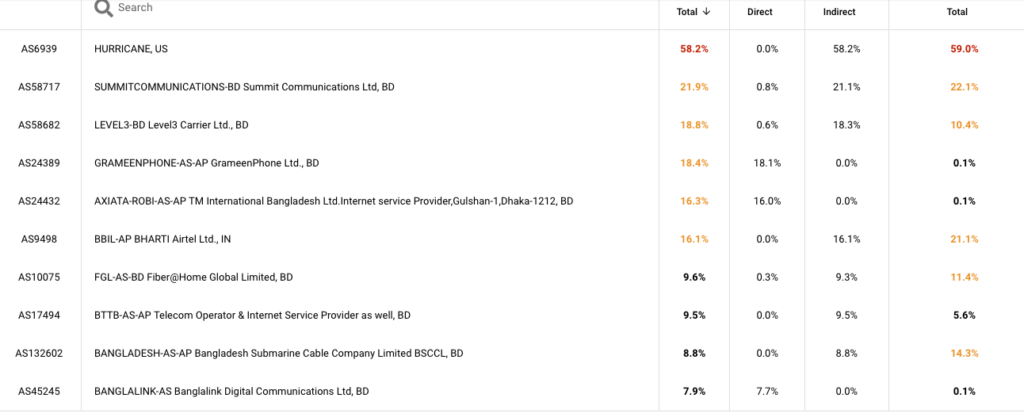
This means if Hurricane Electric were to ever go offline this would disrupt over half of the ISPs in Bangladesh, a scenario that recently played out in Italy. Interestingly, this figure has decreased from 65% since May 2023.
Greater diversity of transit providers is important for maintaining Internet resilience, market competition, and Internet affordability. All three of these have been somewhat compromised in recent years following the decision by the Bangladesh Telecommunication Regulatory Commission (BTRC) requiring all ISPs to purchase bandwidth from at least one registered IIG. This has created a bottleneck with consequences that became evident after the recent fire.
Redundancy helps but costs money
Large local transit providers (those providing transit services to more than 9% of Bangladesh’s networks), such as AS58717 (Summit Communications-BD), AS58682 (Level-3), and AS10075 (Fibre@Home), which all were reported to have had IIGs located in Khawaja Tower, were able to reroute traffic quickly via other points of presence (PoPs) and, as such, saw minimal or no change in Internet connectivity.
However, smaller transit providers (those providing transit services to 5 to 9% of Bangladesh’s network providers) such as AS139009 (Windstream Communication Limited) and AS58715 (Earth Telecommunication), saw more prolonged impacts on connectivity.
Given the impact that this fire had on total Internet connectivity for the economy, it seems that these smaller transit providers are collectively servicing a considerable number of ISPs. One reason for this is that these smaller transit providers may be cheaper than larger ones, which helps the 2,000+ hyper-local ISPs remain competitive while aligning with the BTRC’s new requirements.
However, many of these smaller transit providers keep costs down by not having as much redundancy (PoPs). The issue in this case was that many of these smaller transit providers had one of their limited points of presence located in the same location as others, which compounded the effect.
The need for local data more important than ever
Another important aspect of this event to consider is the importance of data centres and Internet Exchange Points (IXPs) serving local content. If we look at the Internet Resilience Index Profile for Bangladesh (Figure 5) we can see that these enabling infrastructures have respective scores of 4% and 19%.

Data centres play an increasingly important role in the Internet as they allow providers of data-intensive services such as video streaming to store local copies of content closer to Internet users. This reduces the time (latency) it takes to receive such content, which traditionally you would have had to have accessed via another economy.
With such a relatively low number of data centres, the effect of having two data centres knocked out by the fire, especially these two specific data centres that were servicing so many transit providers, was always going to be felt. According to one report, one of these data centres provided 70% of broadband Internet services nationally.
IXPs play an equally important role in keeping traffic local. In this case, we can see the significant effect that this fire has had on ISPs trying to access this local content (Figure 6) with traffic dropping from around 140G to 60G during peak hours on Friday, 27 October.
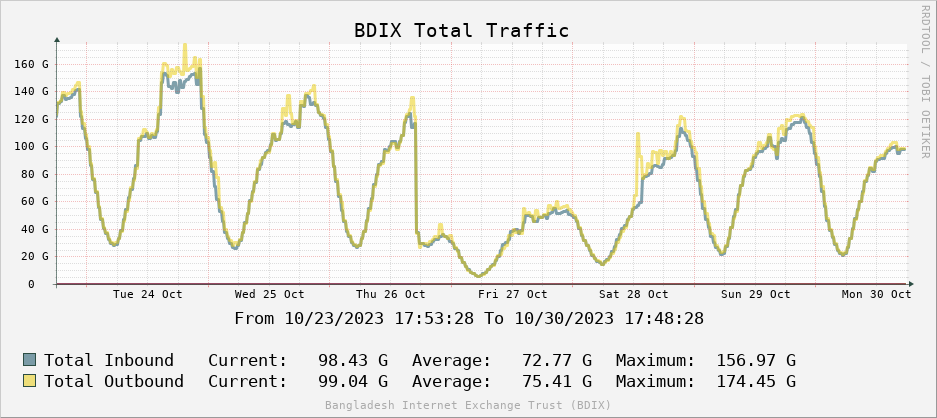
Measuring Internet resilience requires a holistic view
While this incident is another example of the fragility of Bangladesh’s Internet infrastructure, it’s important to note that other components need to be considered when assessing its overall resilience.
Bangladesh’s Internet Resilience Index score is 51%, which is 5% higher than the overall average for Asia and ranks only behind Bhutan for South Asia (Figure 7).
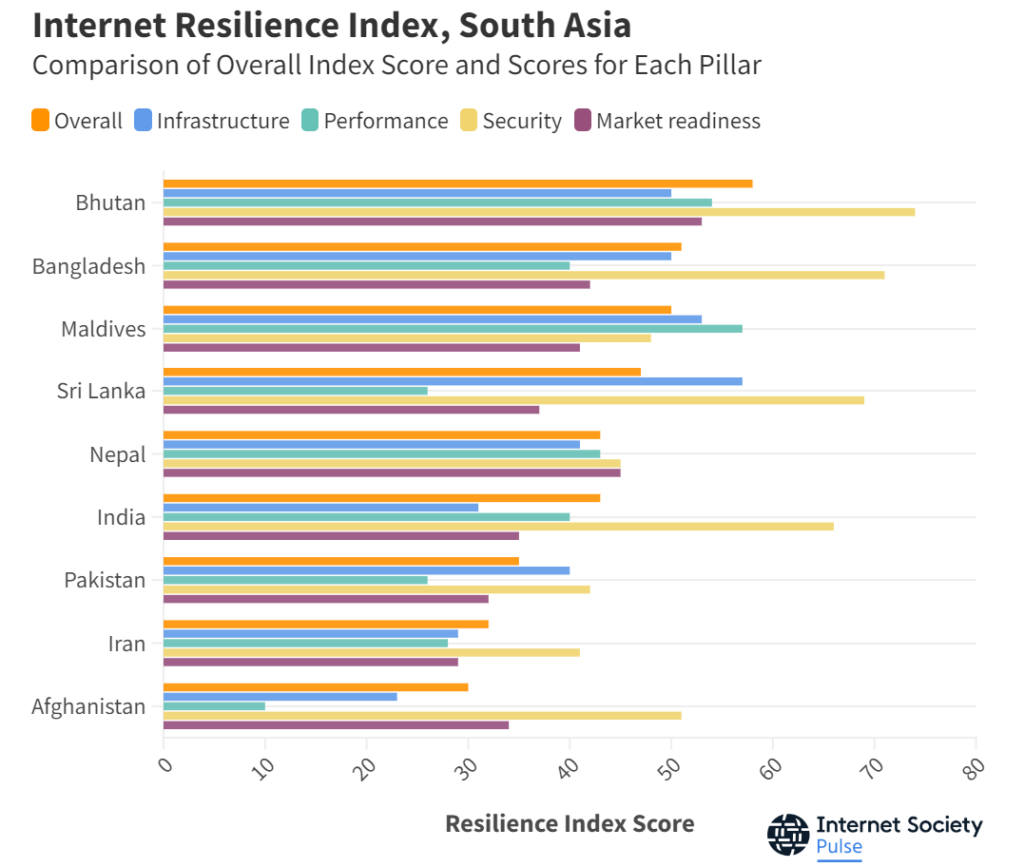
While the focus has been on components that relate to Internet Infrastructure in this post, the score for this pillar is a respectable 50% (above average for Asia) and is its second-highest ranking pillar after Security (71%) (Figure 7).
It could be argued that the two pillars that need the most attention are Performance (40%) and Market Readiness (42%). In relation to the latter, we can see how Upstream Provider Diversity and Peering Efficiency score rather low, which relates to much of what we’ve discussed in this post (Figure 5).
To be fair, market readiness is something that all economies in South Asia and other regions of the world are struggling with. Importantly, low-cost Internet access is not the driving factor — in many cases it is often influenced by a combination of policies to encourage greater competition, and deploying and supporting networks to connect to IXPs, which reduce transit costs and lower latency by keeping traffic local.
The Internet Society Internet Resilience Index (IRI) aims to offer these insights and more to help network operators and decision makers identify weaknesses in their Internet resilience and make data-driven decisions to address these.
Are you interested in the Internet’s health, availability, and evolution? Register to join a special session on Internet Society Pulse.
Robbie Mitchell is a Senior Communication and Technology Advisor at the Internet Society, with interests in Internet measurement and resilience.
This post was adapted from the original at Internet Society Pulse.
The views expressed by the authors of this blog are their own and do not necessarily reflect the views of APNIC. Please note a Code of Conduct applies to this blog.

